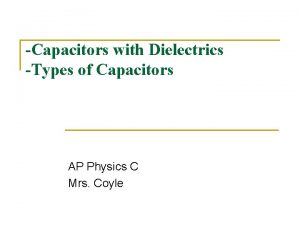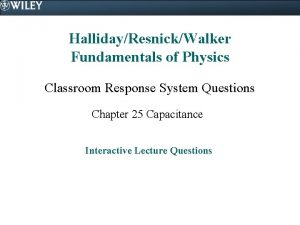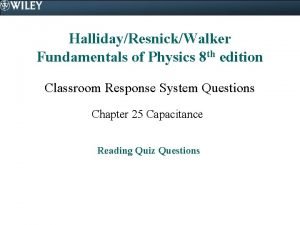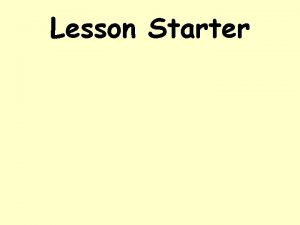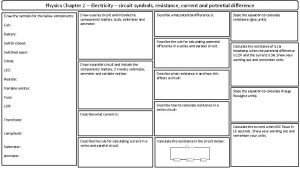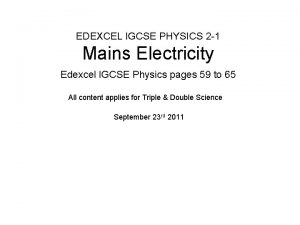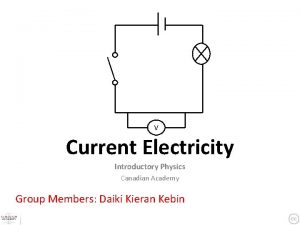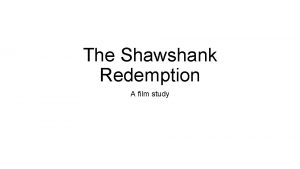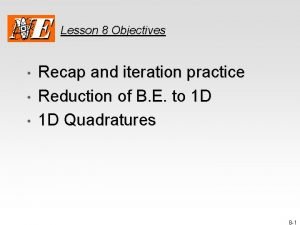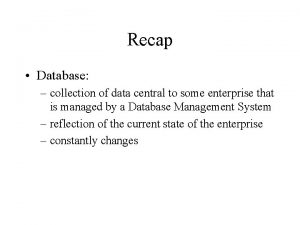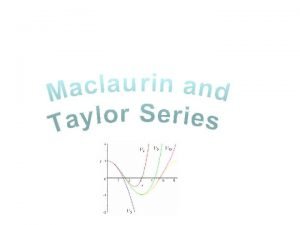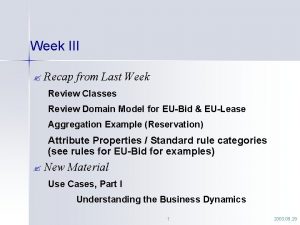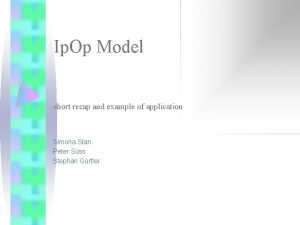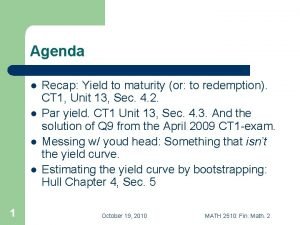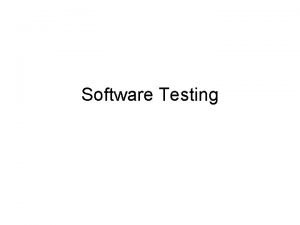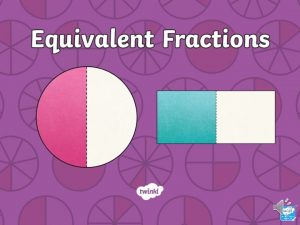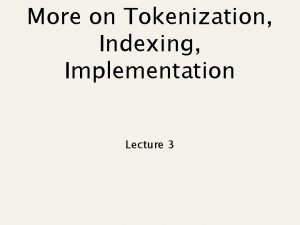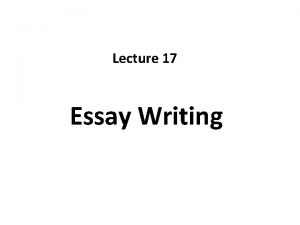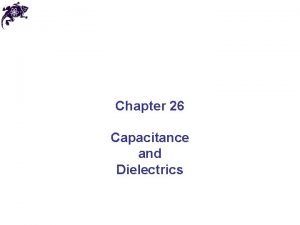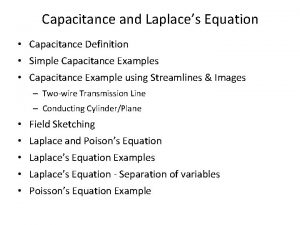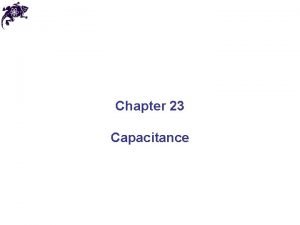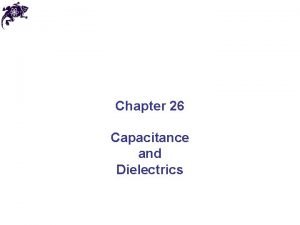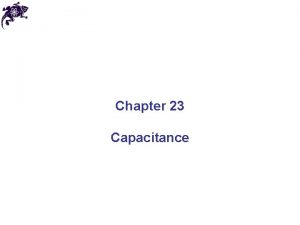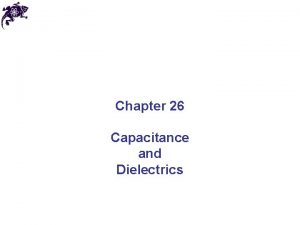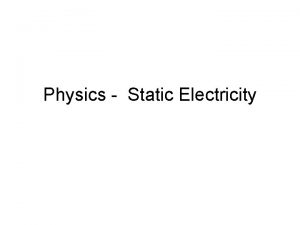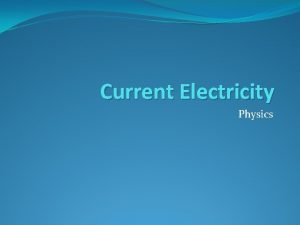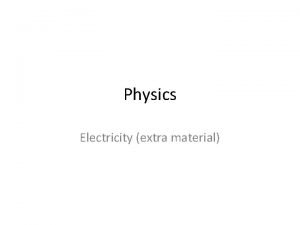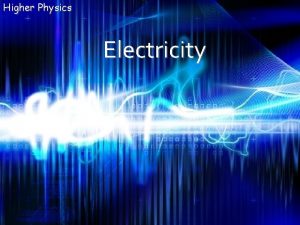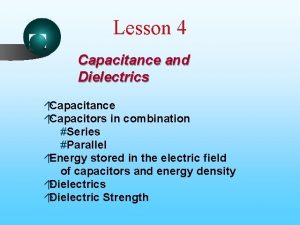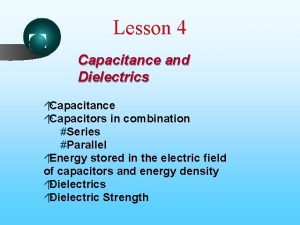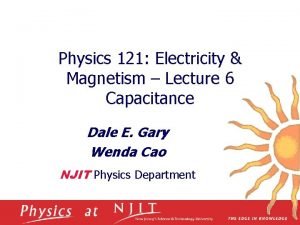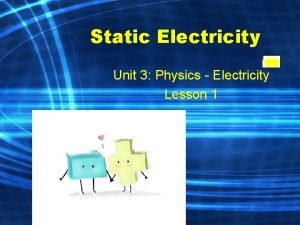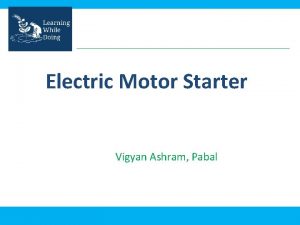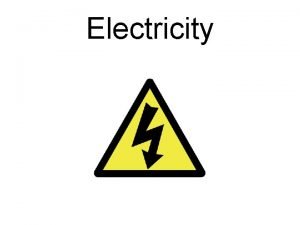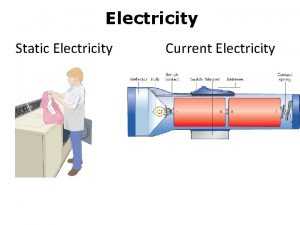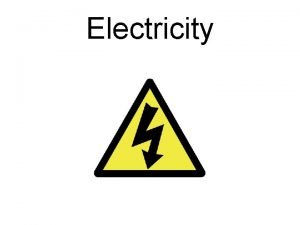Higher Physics Lesson Starter Electricity Capacitance Capacitance Recap


































- Slides: 34

Higher Physics

Lesson Starter

Electricity

Capacitance

Capacitance Recap https: //www. youtube. com/w atch? v=u-jiga. MJT 10

CAPACITORS are devices which can store charge. The ability of a device to store charge is called its capacitance. A capacitor is two conducting layers separated by an insulator. Circuit symbol:

Storing Charge can be stored on parallel metal plates by connecting them to a d. c. source. Electrons leave one plate and at the same time electrons are added to the other plate. The energy to cause this transfer of charge from one plate to the other is the work done by the source. Small voltage e- e- e- echarged

The plates build up charge until the p. d. across the plates is equal to the p. d. of the source. p. d. (V) Time

Q Q = CV V The charge Q on a capacitor is directly proportional to the p. d. V across the capacitor.

Capacitance C is the ratio of charge to p. d. The unit of capacitance is the Farad, F. One Farad is one Coulomb per Volt. The Farad is an impractically large unit, and in practice the μF (x 10 -6 F), n. F (x 10 -9 F), or p. F (x 10 -12 F), are used.

The parallel plates store the energy supplied to them in an electric field between the plates. When the source is disconnected, the charge and energy are stored.

2009 Q 11 2009: 11 C

2002 Q 11 B

2003 Q 13 C

Energy Stored in a Capacitor

- + - + - + + + + Electron flow Consider the movement of electrons in a circuit charging capacitor as shown above. Initially, there will be a surge of electrons from the negative terminal of the cell onto one of the plates (and electrons out of the other plate).

Once some charge is on the plate, this will repel more charge and so the current decreases until the electrons from the cell do not have enough energy to ‘climb’ the potential gradient onto the plate. The charging then ceases. In this way, work is done in charging the capacitor.

Work Done in Charging a Capacitor I I + + - Work must be done (against the electrostatic forces) when pushing electrons on to the negative plate and pulling them off the positive plate. This work becomes energy stored in the electric field between the plates of the capacitor.

The work done in charging a capacitor is given by the area under the graph of charge against p. d. Q V Energy stored in a capacitor = ½ x b x h = ½ x charge x p. d. =½x. Qx. V

We already know that Q = CV. Therefore, we can write: Energy stored in Capacitor = ½ QV = ½ CV² = ½ Q²/C

Investigating Charge On and P. D. Across the Plates of a Capacitor 1. Discharge the capacitor by shorting with connecting lead. 2. Connect the circuit and set the switch to charge the capacitor as shown in the diagram. 3. Allow enough time for the capacitor to charge fully and record voltage, V. 4. Set the switch to B to fully discharge the capacitor through the coulomb meter and record charge, Q. 5. Repeat for other supply voltages.

Charging & Discharging Capacitor Graphs

What we will do today: • State how the voltage of a capacitor varies over time for both a charging and discharging capacitor. • State how the current of a capacitor varies over time for both a charging and discharging capacitor.

RC Circuits The diagram below shows a d. c. circuit containing a resistor and capacitor in series. This is known as an RC circuit, or a CR circuit. A C Vc R

When the Capacitor is Charging… p. d. Supply V Capacito r 47 k 10 k 1 k 0 Time

When the Capacitor is Charging… p. d. Supply V 0 Resistor Time

When the Capacitor is Charging… Current 0 Time

When the Capacitor is Discharging… p. d. Supply V 0 Capacitor Time

When the Capacitor is Discharging… p. d. Resistor Supply V 0 Time

When the Capacitor is Discharging… Current Time 0 Current

Rate of Charging and Discharging The rate at which a capacitor charges and discharges depends on the values of C and R. The larger the value of R, the longer the time. The larger the value of C, the longer the time.

Charging Capacitors p. d. (V) Current (A) Time In a d. c. circuit, when a capacitor is fully charged, no more current flows. The capacitor BLOCKS d. c.

Discharging Capacitors Current (A) p. d. (V) Time Because the voltage across the resistor and the current in the circuit are directly proportional, it is not surprising that these graphs have the same shape.

A. C. Circuits and Capacitance In an a. c. circuit, the capacitor opposes the alternating current, but does not block it completely. The opposition becomes less as the frequency of the supply increases. As a result, current increases as the frequency increases in an a. c. circuit.
 Static electricity and current electricity
Static electricity and current electricity Current electricity gif
Current electricity gif How are static electricity and current electricity alike
How are static electricity and current electricity alike Ap physics c capacitance
Ap physics c capacitance Capacitance physics classroom
Capacitance physics classroom Farad is equivalent to
Farad is equivalent to Lesson starter
Lesson starter Physics 102 electricity and magnetism
Physics 102 electricity and magnetism Ib physics electricity and magnetism
Ib physics electricity and magnetism Physics circuits symbols
Physics circuits symbols Igcse physics electricity questions and answers
Igcse physics electricity questions and answers What is current electricity in physics
What is current electricity in physics Resumen de the shawshank redemption
Resumen de the shawshank redemption Sparknotes chapter 8 the great gatsby
Sparknotes chapter 8 the great gatsby Segmented pricing
Segmented pricing What is the purpose of an iteration recap
What is the purpose of an iteration recap Recap intensity clipping
Recap intensity clipping 60 minutes recap
60 minutes recap Recap database
Recap database Bracket power rule
Bracket power rule Recap introduction
Recap introduction Recap introduction
Recap introduction Recap from last week
Recap from last week Questions for act 2 of the crucible
Questions for act 2 of the crucible Ezekiel cheever motivation
Ezekiel cheever motivation Logbook recap example
Logbook recap example Ytm recap
Ytm recap Black box recap
Black box recap Fractions recap
Fractions recap Recap
Recap Without graphing identify the quadrant in which the point
Without graphing identify the quadrant in which the point Recap indexing scans
Recap indexing scans Just a quick recap of what we discussed
Just a quick recap of what we discussed Recap poster
Recap poster Public transportation essay
Public transportation essay



